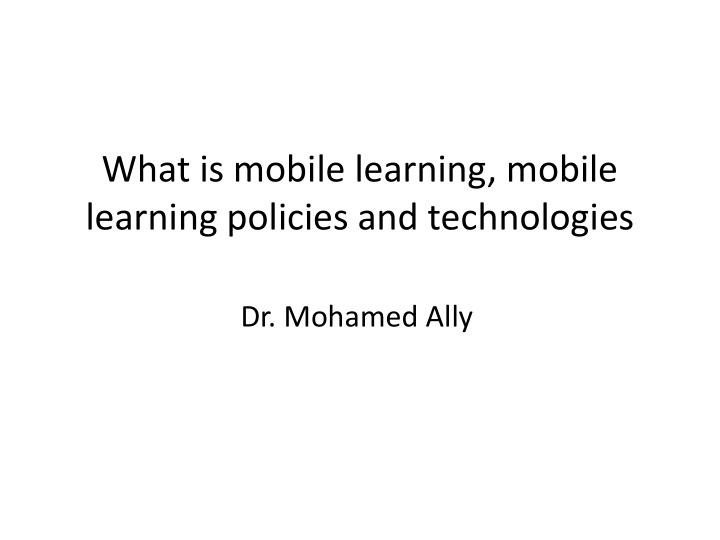



What is mobile learning, mobile learning policies and technologies Dr. Mohamed Ally
Learning Outcomes • Define mobile learning. • Describe policies for mobile learning. • Identify mobile learning technologies.
Definition of Mobile Learning • Learning using information and communication technologies in mobile contexts - ISO/IEC 29140-2 (TR) • Other definitions – Mobile learning is the delivery of electronic learning materials on mobile computing devices to allow access from anywhere and at anytime ( Ally, 2004 ). – Mobile learning can be defined as learning using mobile and wireless computing technologies in a way to promote learners’ mobility and nomadicity nature ( Shon, 2008 )
Definition of Mobile Learning (cont’d) • Any sort of learning that happens when the learner is not at a fixed, predetermined location, or learning that happens when the learner takes advantage of learning opportunities offered by mobile technologies ( O’Malley et al., 2003 ) • The processes of coming to know through conversations across multiple contexts amongst people and personal interactive technologies ( Sharples, Taylor, & Vavoula, 2007 )
Characteristics of Mobile Learning • Anytime • Anywhere • Learner is mobile • Learn in context • Location based learning • Just in time learning • Formal and informal learning
Setting Standards for Mobile Learning • Participated on a ISO standards committee to set standards for mobile learning for learners on the move (nomadic learners) – International committee (Canada, South Korea, Germany, Luxembourg)
Sample policies for mobile learning (UNESCO, 2013) • Train teachers on mobile learning • Provide support to teachers who are implementing mobile learning • Design efficient content for delivery on mobile devices • Ensure gender equality in mobile learning • Ensure adequate connectivity • Develop strategies to provide devices for students who cannot afford them • Promote the safe, responsible, and healthy use of mobile technologies
Generations of Technology in Education • First Generation: Correspondence • Second Generation: Print with telephone support • Third Generation: E-learning • Fourth Generation: Mobile learning • Fifth Generation: Ubiquitous learning
Learners have multiple devices
Virtual Devices
Wearable Devices
Future of Technology • According to a recent Futurelab report, by 2020, digital technology will be embedded and distributed in most objects • We will not be taking any devices with us, they will exist everywhere • Gesture-based interaction • Emotional computing
Globalization – Shift to Mobility – E-Commerce to M-commerce – E-government to M-government – E-collaboration to M-collaboration – E-library to M-library – E-health to M-health – E-games to M-games
Mobile Technology in Other Sectors • “In the pocket banking” • “A library in everyone’s pocket” • “Health information in everyone’s pocket” • Are we ready for “Education in the pocket”?
Recommend
More recommend